Practice
As with any other instrument, practice is absoulutely necessary. However, this can sometimes lead to friction, because not everybody always enjoys the enticing sound of a bodhrán. In order to save neighbors and co-inhabitants grief, I came up with an ingeniously simple solution — an old mousepad!
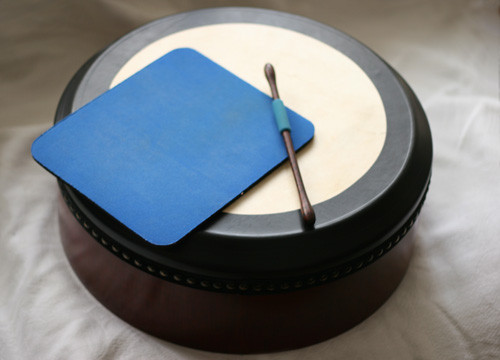
Everybody probably has one at home, probably also out of use, since modern optical mice do not require mousepads any more. To lower the volume of your bodhrán, simply press the mousepad against the drum with your skin hand — done:
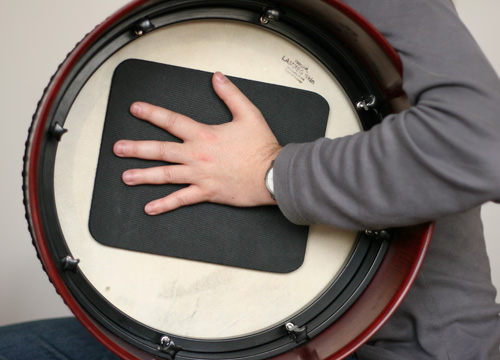
The disadvantage of this is of course, that the skin hand cannot perform any actions, such as taking away the skin hand for a bass sound, or pushing in the skin. But if your plan was to play softly, chances are that you wanted to avoid the loud bass anyway.
If you want to be even softer, you can also put aside the drum and just play on the mousepad itself. This variant may be interesting for an office environment as well.
Exercises
Here I put together a few exercises that seemed useful to me. The selection is in no systematic order, just pick what you like and leave the rest.
Grooving Reel Variations with Bass Accents
With this simple reel, you can practice the coordination between tipper hand and skin hand. In the first and second bar, the tipper hand makes an acccent on beat three, again marked by a ">" above the notes. But in addition, there now is a bass accent on beat one of each bar. In the diagram, this is marked by a "B" underneath the notes.
The bass accent is produced by briefly lifting the hand from the skin and immediatlely putting it back to the skin again — as gently as possible in the heat of the action, because the skin hand is not supposed to produce an unwanted "popping" sound of its own while doing this:
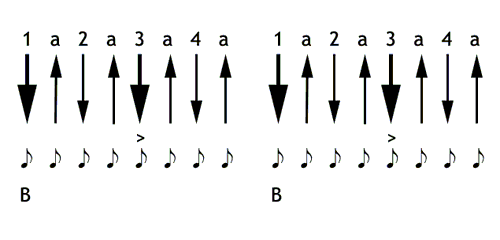
A first variation introduces an additional bass accent on beat four of the first bar. This pattern suddenly has much more "drive":
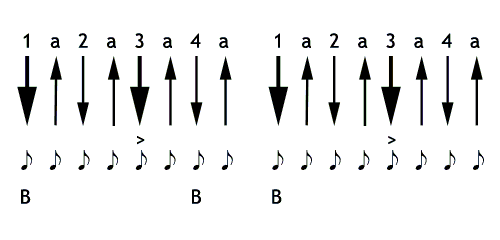
For the next variation, we return to the basic pattern in the first bar. In the second bar, however, we shift the bass accent to beat two:
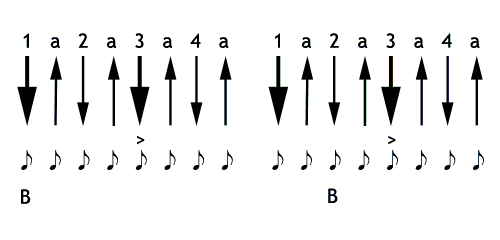
In the fourth pattern, we now combine the already familiar shifted bass accents in both bars:
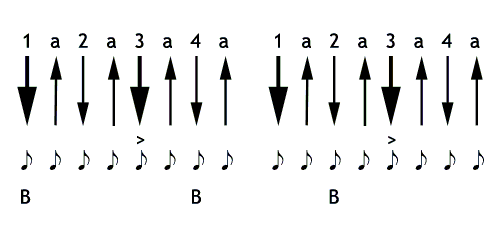
When you have mastered the coordination between tipper hand and skin hand, try pushing in the skin with the skin hand while playing the accents with the tipper hand. You might also vary the point of impact of the tipper on the skin. The result is a nice groove, wavering between bass sound, regular sound and a higher pitched accent.
Paradiddle
The Paradiddle is a well known exercise with drummers and a technique originally hailing from jazz music. The systematic alteration of single and double strokes, that are performed by the right and the left hand, facilitates play of extensive uniform patterns and trains the independance of the hands. With the bodhrán, the beats with the right and left hand are "translated" into up- and downstrokes. The exercise is particularly useful for training uniform upstrokes:
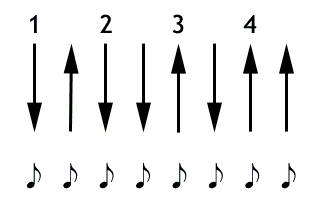
Start out at slow speed and gradually increase speed. Try to achieve even beats that are as regular as beads on a necklace. Eventually try to place accents.
Jig Variations
Each of the following three jig beat patterns consists of two bars. While all three examples are rhythmically identical, you will find out they sound differently. The individual sound is a result of the varying position of downstrokes und upstrokes, because downstrokes and upstrokes simply have different accentuation.
The first bar is always without a triplet, the second bar is with a triplet. Here, the triplet is marked with a "T" between the arrows for the beats involved.
Beginners should only concern themselves with the first bar of each variation. People that know how to produce the triplet or roll, add the second bar. Repeat both bars when you are through.
These exercises not only are aimed at practicing the double downstroke. If you can play all three variantions at ease, you will be able to place a downstroke on any of the six beats of the jig you desire.
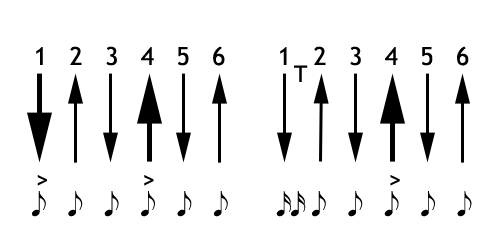
The first bar of the first variantion is identical with the jig in the Basic Rhythm Tutorial. The triplet in the second bar is on beat one — as in the other variations.
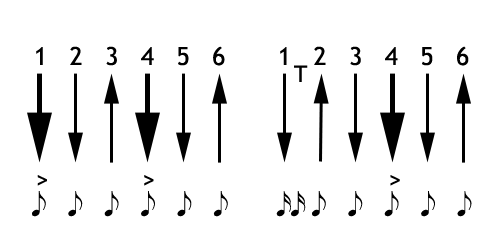
In the first bar of the second variation, the downstroke on beat one and beat four is immediately followed by another downstroke. This pattern is preserved in the second bar after beat four. Since there is a triplet on beat one and two which ends with an upstroke, a downstroke follows on beat three. This is why the second bar features three consecutive downstrokes (on beats three, four and five), which can be a bit uncomfortable to play.

In the first bar of the third variation, we combine the double downstroke with the "normal" jig pattern. Thus, in the second bar, we "only" have one double downstroke, on beats three and four.
Advanced players may combine bars from all three different variations at will, e.g. bar 1 from variantion 3 with bar 2 from variantion 1 and so forth.